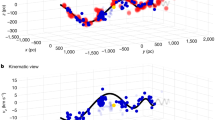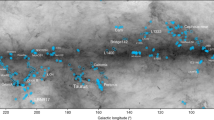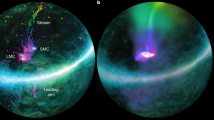Abstract
Massive stars influence their parental molecular cloud, and it has long been suspected that the development of hydrodynamical instabilities can compress or fragment the cloud1,2. Identifying such instabilities has proved difficult. It has been suggested that elongated structures (such as the ‘pillars of creation’3) and other shapes arise because of instabilities4,5, but alternative explanations are available6,7. One key signature of an instability is a wave-like structure in the gas, which has hitherto not been seen. Here we report the presence of ‘waves’ at the surface of the Orion molecular cloud near where massive stars are forming. The waves seem to be a Kelvin–Helmholtz instability that arises during the expansion of the nebula as gas heated and ionized by massive stars is blown over pre-existing molecular gas.
This is a preview of subscription content, access via your institution
Access options
Subscribe to this journal
Receive 51 print issues and online access
$199.00 per year
only $3.90 per issue
Buy this article
- Purchase on Springer Link
- Instant access to full article PDF
Prices may be subject to local taxes which are calculated during checkout



Similar content being viewed by others
References
Tenorio-Tagle, G. & Bodenheimer, P. Large-scale expanding superstructures in galaxies. Annu. Rev. Astron. Astrophys. 26, 145–197 (1988)
Woodward, P. R. Shock-driven implosion of interstellar gas clouds and star formation. Astrophys. J. 207, 484–501 (1976)
Hester, J. J. et al. Hubble Space Telescope WFPC2 imaging of M16: photoevaporation and emerging young stellar objects. Astron. J. 111, 2349–2360 (1998)
Spitzer, L. Physical Processes in the Interstellar Medium 223–225 (Wiley-Interscience, 1978)
Rodriguez-Franco, A., Martin-Pintado, J., Gomez-Gonzales, J. & Planesas, P. Large-scale interaction of the H II region and the quiescent gas in Orion A. Astron. Astrophys. 264, 592–609 (1992)
Pound, M. W. Molecular gas in the Eagle nebula. Astrophys. J. 493, L113–L116 (1998)
Pound, M. W., Reipurth, B. & Bally, J. Looking into the Horsehead. Astron. J. 125, 2108–2122 (2003)
Menten, K. M., Reid, M. J., Forbrich, J. & Brunthaler, A. The distance to the Orion nebula. Astron. Astrophys. 474, 515–520 (2007)
Genzel, R. & Stutzki, J. The Orion molecular cloud and star-forming region. Annu. Rev. Astron. Astrophys. 27, 41–85 (1989)
Bally, J. in Handbook of Star Forming Regions: Vol. I, The Northern Sky (ed. Reipurth, B.) 459–473 (ASP Monogr. Publ. 4, Astronomical Society of the Pacific, 2008)
Güdel, M. et al. Million-degree plasma pervading the extended Orion nebula. Science 319, 309–311 (2008)
Neufeld, D. A. et al. Spitzer spectral line mapping of protostellar outflows. I. Basic data and outflow energetics. Astrophys. J. 706, 170–183 (2009)
Lefloch, B. et al. Warm molecular hydrogen and ionized neon in the HH 2 outflow. Astrophys. J. 590, L41–L44 (2003)
Tappe, A., Lada, C. J., Black, J. H. & Muench, A. A. Discovery of superthermal hydroxyl (OH) in the HH 211 outflow. Astrophys. J. 680, L117–L120 (2008)
Bachiller, R. Bipolar molecular outflows from young stars and protostars. Annu. Rev. Astron. Astrophys. 34, 111–154 (1996)
Tielens, A. G. G. M. et al. Anatomy of the photodissociation region in the Orion bar. Science 262, 86–89 (1993)
Berné, O. et al. Mid-infrared polycyclic aromatic hydrocarbon and H2 emission as a probe of physical conditions in extreme photodissociation regions. Astrophys. J. 706, L160–L163 (2009)
Kaufman, M. J. & Wolfire, M. G. & Hollenbach, D. J. [Si II], [Fe II], [C II], and H2 emission from massive star-forming regions. Astrophys. J. 644, 283–299 (2006)
Chandrasekhar, S. Hydrodynamic and Hydromagnetic Stability Ch. XI (Int. Ser. Monogr. Phys., Clarendon, 1961)
Ryutov, D. D., Kane, J. O., Pound, M. W. & Remingtom, B. A. Instability of an ablatively-accelerated slab in the case of non-normal irradiation. Plasma Phys. Contr. Fusion 45, 769–781 (2003)
Ryutov, D. D., Kane, J. O., Mizuta, A., Pound, M. W. & Remington, B. A. Phenomenological theory of the photoevaporation front instability. Astrophys. Space Sci. 307, 173–177 (2007)
Johnstone, D., Hollenbach, D. & Bally, J. Photoevaporation of disks and clumps by nearby massive stars: application to disk destruction in the Orion nebula. Astrophys. J. 499, 758–776 (1998)
Bally, J., Licht, D., Smith, N. & Walawender, J. Irradiated and bent jets in the Orion nebula. Astron. J. 131, 473–500 (2006)
Schuster, K.-F. et al. A 230 GHz heterodyne receiver array for the IRAM 30m telescope. Astron. Astrophys. 423, 1171–1177 (2004)
Weingartner, J. C. & Draine, B. T. Dust grain-size distributions and extinction in the Milky Way, Large Magellanic Cloud, and Small Magellanic Cloud. Astrophys. J. 548, 296–309 (2001)
Wilms, J., Allen, A. & McCray, R. On the absorption of X-rays in the interstellar medium. Astrophys. J. 542, 914–924 (2000)
Acknowledgements
We thank J. Bally and M. Pound for their comments, which contributed to the improvement of the manuscript. We also acknowledge B. Lefloc’h, J. Goicoechea and J. Martín-Pintado for discussions. D. Hochberg is acknowledged for his reading of the manuscript. O.B. acknowledges C. Joblin for support. This work is based in part on observations made with the Spitzer Space Telescope, which is operated by the Jet Propulsion Laboratory, California Institute of Technology under a contract with NASA.
Author information
Authors and Affiliations
Contributions
O.B. conducted the scientific analysis and write-up of the paper. N.M. conducted the CO observations and analysis. J.C. initiated the project and was its principal investigator.
Corresponding author
Ethics declarations
Competing interests
The authors declare no competing financial interests.
Supplementary information
Supplementary Information
This file contains Supplementary Data, Supplementary Figures 1-2 with legends and References. (PDF 290 kb)
Supplementary Movie 1
This video shows the CO emission of the Orion cloud at all velocities observed with the IRAM 30m telescope. The KH arrow shows the position of the waves. (MP4 1039 kb)
Rights and permissions
About this article
Cite this article
Berné, O., Marcelino, N. & Cernicharo, J. Waves on the surface of the Orion molecular cloud. Nature 466, 947–949 (2010). https://doi.org/10.1038/nature09289
Received:
Accepted:
Issue Date:
DOI: https://doi.org/10.1038/nature09289
This article is cited by
-
Particle energization in space plasmas: towards a multi-point, multi-scale plasma observatory
Experimental Astronomy (2022)
-
Astromodal wave dynamics in multifluidic structure-forming cloud complexes
Pramana (2021)
-
Kelvin–Helmholtz Instability: Lessons Learned and Ways Forward
Space Science Reviews (2018)
-
Compression and ablation of the photo-irradiated molecular cloud the Orion Bar
Nature (2016)
-
Blast-wave driven Kelvin-Helmholtz shear layers in a laser driven high-energy-density plasma
Astrophysics and Space Science (2011)
Comments
By submitting a comment you agree to abide by our Terms and Community Guidelines. If you find something abusive or that does not comply with our terms or guidelines please flag it as inappropriate.



